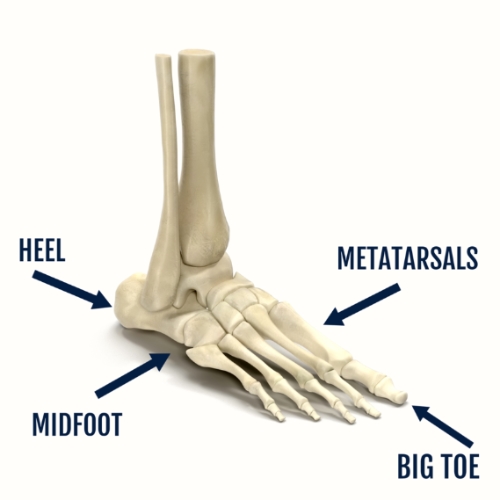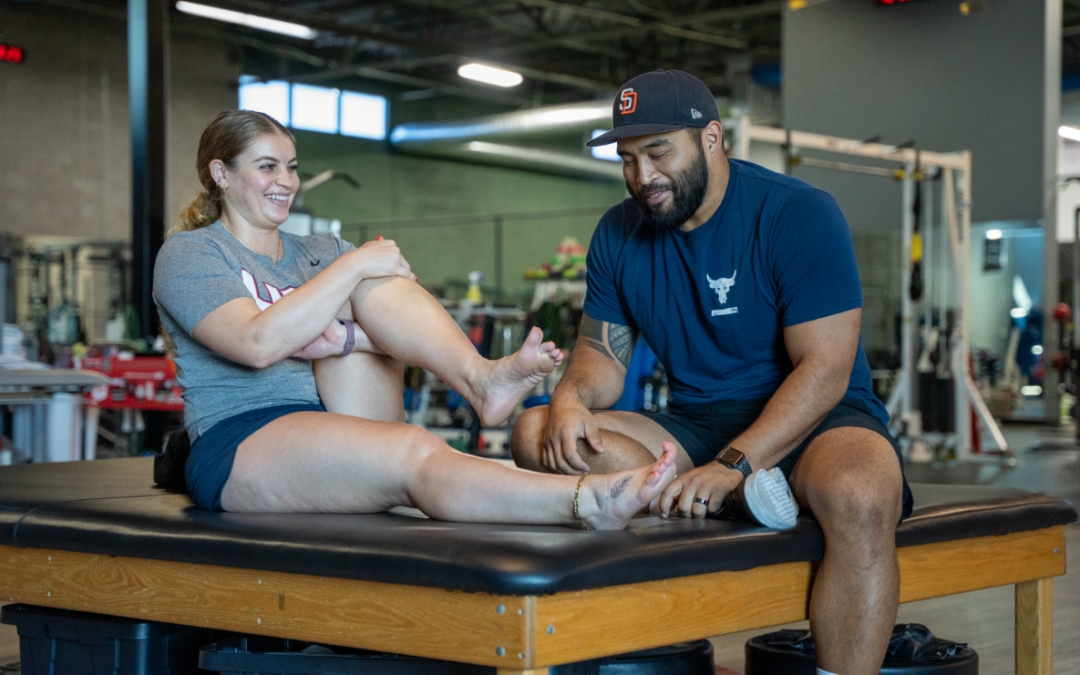By: Nick Thomas, MS, ATC, CES, PES, Chip Gosewisch, CSCS, RSCC, FRCms, and Charleston DeLa Cruz, CSCS, USAW-1, FRSC, FRCms
If you are building a house, the foundation impacts everything. A solid foundation allows for a strong house that will be able to be built properly and stand the test of time. A weak foundation leads to problems and compensations that can affect every aspect of the house.
The same can be said for your feet. If there is a dysfunction or injury in your foot, then that can impact your body up the kinetic chain. Strength, power, and stability are all built from the ground up.
Learn more about the kinetic chain in What Are Kinetic Chain Reactions
Your foot has three pillars- the heel, the metatarsal head of your pinky toe, and the metatarsal head of your big toe. Dysfunction or injury in any of these pillars can cause compensation and a possibly even further injury somewhere higher up your body. Your big toe, specifically, has a key role in your body’s mechanical function and athletic performance.
Functions of the Big Toe
Let’s start with walking. In kinetic chain reactions, one motion stimulates a multitude of other motions in the body. Looking specifically at the big toe in walking mechanics, your big toe digs into the ground to create a midfoot drop that then pulls your heel up off the ground. As your big toe flexes while your heel raises, you can generate power. It is a springboard from which you can push off the ground. When you step down, 86% of your body weight is absorbed by your metatarsal joints, and the majority of that is absorbed by your big toe1.
 So, when we just look at the mechanics of walking, the big toe is responsible for creating the arch, transferring power, and absorbing impact. When you move up the kinetic chain, you are internally and externally rotating based on the extension of your big toe. If your big toe has any sort of dysfunction, your foot can supinate- the weight that you are loading through your step is now being placed fully along the outside of your foot. This leads to further compensation from the ground up.
So, when we just look at the mechanics of walking, the big toe is responsible for creating the arch, transferring power, and absorbing impact. When you move up the kinetic chain, you are internally and externally rotating based on the extension of your big toe. If your big toe has any sort of dysfunction, your foot can supinate- the weight that you are loading through your step is now being placed fully along the outside of your foot. This leads to further compensation from the ground up.
Other major factors, like balance and stability, are fully dependent on your big toe. It grips you to the ground, creates your arch, and holds a great deal of the load while standing.
There are a few major dysfunctions that can occur in the big toe that impact its functionality:
- Bunions: Bunions cause you to push off a different part of your toe based on foot position. This puts stress along that joint, and that toe is getting pushed over. You are going over the joint rather than moving through the correct flexion of the toe while walking, which then leads to other compensations in the kinetic chain.
- Turf Toe: This is a restriction in the extension of the big toe, which, in turn, limits the amount of power you can push out of it.
- Any limited range of motion in the joint.
- Other fractures, tendinopathies, and tendon ruptures will also impact its functionality.
To maximize the functionality of your big toe, foot intrinsic exercises are necessary.
- Toe Cars: You can do this exercise while balancing on one leg or, to start out, stand normally. Plant your big toe into the ground and lift the other four toes. Then, do the opposite. When you’re balancing, make sure you are intentionally pushing your big toe into the ground, creating an arch, and not rolling to the outside of your foot.
- Toe Press: Get a resistance band a set one end of it under a weight. While standing on one leg, place the other end of the band under your big toe. When you’re balancing, you’ll notice when you take the pressure off your big toe, the band will release. It’s a good way to keep your toe down.
The big toe is such an integral part of your functionality that it is often overlooked. However, when something is wrong with it, it changes everything. It can lead to a knee problem, an ankle problem, a hip problem, or even impact your athletic performance.
The Big Toe and Performance
Proprioception is one of the foundations for coordination, movement, and athleticism. So, it is vital for athletes to be to connect their feet to the ground to improve their athletic performance. Utilizing and strengthening their big toe adds to their dynamic and positional training.
Sprinting and other Dynamic Movements
When you are sprinting or jumping, your big toe is the last part of your body to leave the ground. It is also the strike point that you are using as a springboard to generate power and speed. Articulating the big toe not only helps you find that strike point better, it can help you sprint faster and jump higher.
If an athlete’s toe is weak or lacks mobility, they are not able to put enough power into the ground to then generate the ground reaction force necessary for sprinting and jumping. For example, if an athlete is dealing with turf toe on one side, their stride length will suffer on one side. This will affect their entire sprint, and, in turn, result in a slower pace.
Studies have been conducted on the effects of strengthening the toes in isolation as well as training barefoot to see the difference of agility with the connection to the ground. These studies concluded that when the big toe was specifically strengthened and when an athlete could identify their strike point easier on the ground, athletes were performing better1.
Strength Training
As stated above, the big toe is a stabilizer for your entire body. This is especially important during strength training. Your ability to spread your toes and grip the ground puts your joints in the most optimal position for a lift, whether that be deadlifting, squatting, or split squatting. This positioning for strengthening helps with the stability and balance needed in every sport.
During supplemental exercises on the weight room floor with cables or a medicine ball, if an athlete loses contact with their big toe on the ground on the trail leg, that is going to limit their power production because they’ve lost the mechanical advantage. Their weight shifts to the outside of the foot because the big toe leaves the ground, and, once everything above it shifts outside that center of mass, it creates a less powerful position. That, then, directly translates to any change of direction or agility work the athlete does on the field. If they are making a plant or a cut, and the weight shifts to the outside of the foot, they’ll lose contact with that big toe, the ankles and shins start to lean to the outside. This inhibits the power the athletes needs to generate through the big toe.
Your big toe impacts your entire body. If it doesn’t correctly connect with the ground, your entire kinetic chain is compromised. It’s sometimes joked that a pitcher with a big toe restriction will have Tommy John surgery down the line. While this anecdote seems extreme, if the pitcher’s toe can’t extend, then they can’t generate the power they need from their lower body. This can lead to a compensation of power in the upper body.
Taking care of the functionality of your big toe can impact your entire body and help you build strength on a strong foundation.
Spooner physical therapists, occupational therapists, athletic trainers, and strength coaches look at the whole body to see what the root of your pain or dysfunction is. Schedule an appointment today to move and feel your best.
References:
- LaPlaca, David A. PhD, CSCS; Seedman, Joel PhD, CSCS. The Importance of the Foot and Ankle in Athletic Performance. Strength and Conditioning Journal. 2021; 43(3): 67-79. doi: 10.1519/SSC.0000000000000598. https://journals.lww.com/nsca-scj/abstract/2021/06000/the_importance_of_the_foot_and_ankle_in_athletic.6.aspx

